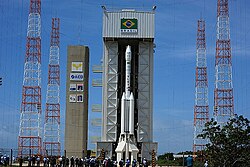VLS-1

VLS launch
|
|
| Function | Orbital launch vehicle |
|---|---|
| Manufacturer | CTA |
| Country of origin | Brazil |
| Size | |
| Height | 19.5 m (63.9 ft) |
| Diameter | 1.01 m (3.31 ft) |
| Mass | 50,700 kg (111,700 lb) |
| Stages | 3 |
| Capacity | |
| Payload to LEO | 380 kg (830 lb) |
| Launch history | |
| Status | Cancelled |
| Launch sites | Centro de Lançamento de Alcântara |
| Total launches | 2 |
| Failures | 2 |
| First flight | 2 November 1997 |
| Boosters - S-43 | |
| No. boosters | 4 |
| Engines | 1 Solid |
| Thrust | 303 kN (68,100 lbf ) |
| Specific impulse | 225 s (2.21 kN·s/kg) |
| Burn time | 59 seconds |
| Fuel | Solid |
| First stage - S-43TM | |
| Engines | 1 Solid |
| Thrust | 320.6 kN (72,074 lbf) |
| Specific impulse | 277 s (2.72 kN·s/kg) |
| Burn time | 58 seconds |
| Fuel | Solid |
| Second stage - S-40TM | |
| Engines | 1 Solid |
| Thrust | 208.39 kN (46,848 lbf) |
| Specific impulse | 275 s (2.70 kN·s/kg) |
| Burn time | 56 seconds |
| Fuel | Solid |
| Third stage - S-44 | |
| Engines | 1 Solid |
| Thrust | 33.24 kN (7,473 lbf) |
| Specific impulse | 282 s (2.77 kN·s/kg) |
| Burn time | 68 seconds |
| Fuel | Solid |
| Function | Orbital launch vehicle |
|---|---|
| Manufacturer | CTA |
| Country of origin | Brazil |
| Size | |
| Height | 19.5 m (63.9 ft) |
| Stages | 3 |
| Capacity | |
| Payload to LEO | 600 kg |
| Launch history | |
| Status | In development |
| Launch sites | Centro de Lançamento de Alcântara |
| Boosters - S-43 | |
| No. boosters | 4 |
| Engines | 1 Solid |
| Thrust | 303 kN (68,100 lbf ) |
| Specific impulse | 225 s (2.21 kN·s/kg) |
| Burn time | 59 seconds |
| Fuel | Solid |
| First stage - S-43TM | |
| Engines | 1 Solid |
| Thrust | 320.6 kN (72,074 lbf) |
| Specific impulse | 277 s (2.72 kN·s/kg) |
| Burn time | 58 seconds |
| Fuel | Solid |
| Second stage - L75 | |
| Engines | 1 Liquid |
| Thrust | 7.50 t |
| Fuel | Liquid |
| Function | Orbital launch vehicle |
|---|---|
| Manufacturer | CTA |
| Country of origin | Brazil |
| Size | |
| Stages | 3 |
| Capacity | |
| Payload to LEO | 800 kg |
| Launch history | |
| Status | In development |
| Launch sites | Centro de Lançamento de Alcântara |
| First stage - P40 | |
| Engines | 1 Solid |
| Thrust | 40 t |
| Fuel | Solid |
| Second stage - L75 | |
| Engines | 1 Liquid |
| Thrust | 7.5 t |
| Fuel | Liquid |
The VLS-1 (Portuguese: Veículo Lançador de Satélites) was the Brazilian Space Agency's main satellite launch vehicle. The launch vehicle was to be capable of launching satellites into orbit. The launch site was located at the Alcântara Launch Center due to its proximity to the equator.
Associated vehicles include the Sonda I, Sonda II, Sonda III and Sonda IV, the VS-30, VS-40 and VSB-30.
The VLS was cancelled after decades of development and high expenditures with poor results and a failed association with Ukraine that slowed years the program.
VLS-1 development started in 1984, after the first launch of the Sonda IV rocket. To date, three prototypes have been built and two launches attempted, departing from the Alcântara Launch Center. During the V1 and V2 prototype launches (VLS-1 V1 and VLS-1 V2) technical problems prevented mission success, but allowed the testing of several vehicle components. The V3 prototype exploded on the launch pad on 22 August 2003, two days before its intended launch date. The 2003 Alcântara VLS accident caused a considerable setback to the Brazilian space program. The V4 prototype was expected to be launched in 2016.
The project was terminated by Brazilian Space Agency in 2016.
The Departamento de Ciência e Tecnologia Aeroespacial (DCTA) (Department of Aerospace Science and Technology) and the Agência Espacial Brasileira (AEB) (Brazilian Space Agency) informed on public audience before the VLS-1 project ended by the Senado Federal (Federal Senate) on February 16, 2016.
...
Wikipedia
